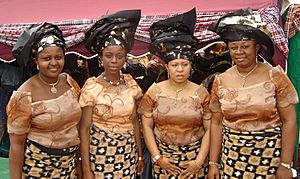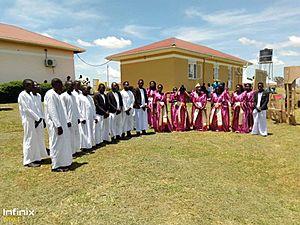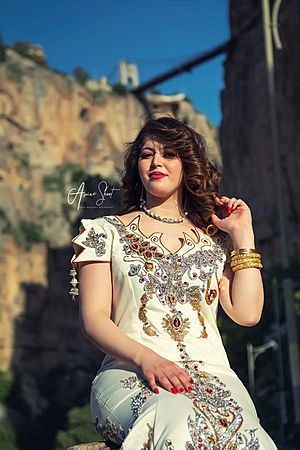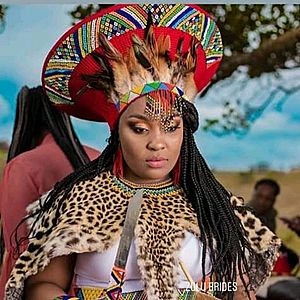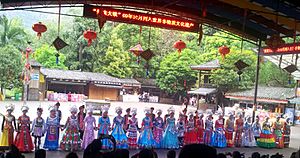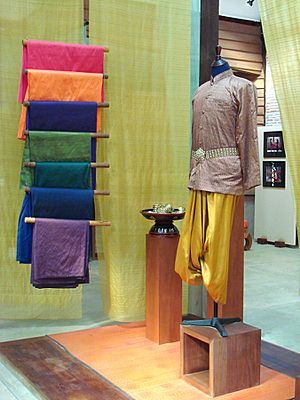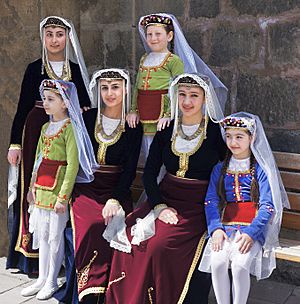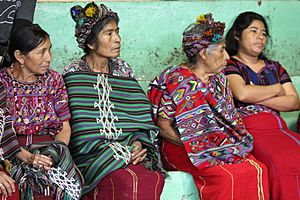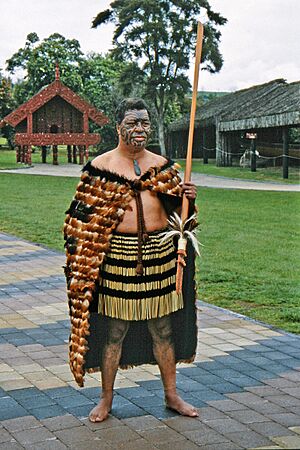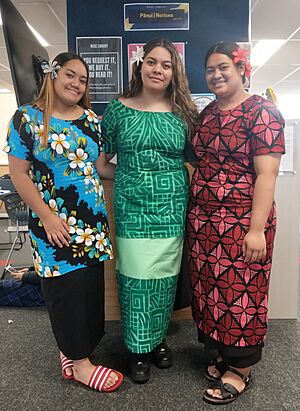Folk costume facts for kids
A folk costume is a special type of clothing. It shows the unique identity of a group of people. These clothes are often linked to a certain place or time in history. They can also tell you about a person's social status, whether they are married, or their religious beliefs. When these clothes represent a specific ethnic group, they are called ethnic costumes.
Folk costumes often come in two main types. One is for everyday wear. The other is for special events like festivals or formal gatherings. Sometimes, people prefer to use the word "regalia" instead of "costume." This is because "costume" can sometimes mean something worn for fun or a play.
Long ago, people in Europe started to value the simple clothes of farmers. They saw these clothes as truly authentic. So, these traditional clothes became symbols of their culture. They were often made from special, old-fashioned fabrics.
Today, in many parts of the world, people usually wear modern clothes. But traditional garments are still worn for special occasions. These include cultural events, heritage celebrations, or times when people want to show their pride. At big international events, you might see a rule like "business suit or national dress." This allows people to wear their traditional clothes.
Sometimes, governments even require people to wear traditional clothes. For example, in Bhutan, everyone must wear the traditional gho for men and kira for women. In Saudi Arabia, women are required to wear the abaya in public.
Contents
Folk Costumes Around the World
Folk costumes are worn all over the globe. Each region and country has its own unique style. Let's explore some of them!
Africa
Africa is a huge continent with many different cultures. This means there are lots of amazing traditional clothes.
Central Africa
- Cameroon – Women often wear Pagne. Men might wear Toghu.
- Democratic Republic of the Congo – Many people wear Pagne.
- Gabon – The Pagne is also common here.
Eastern Africa
- Ethiopia – People wear Kidan Habesha or Habesha kemis. Each ethnic group has its own style.
- Kenya – Kenya does not have one national costume. Different tribes have their own traditional clothes. For example, the Maasai wear colorful Kitenge and Kikoi.
- Rwanda – The Mushanana is a well-known dress.
- Somalia – Men wear Kanzu or Macawiis. Women wear Dirac or Guntiino.
- Uganda – Men wear Kanzu. Women often wear Gomesi.
Northern Africa
- Algeria – Many traditional clothes exist, like the Burnous and Caftan.
- Egypt – The Galabeya is a common traditional dress.
- Morocco – Men wear Djellaba and a Fez hat. Women might wear a Takchita.
- Tunisia – The Jebba and Chechia are traditional.
Southern Africa
- Lesotho – People wear Shweshwe clothing and blankets. The Mokorotlo is a special hat.
- South Africa – Different groups have their own styles.
- Zimbabwe – The Chitenje is a common fabric for clothing.
Western Africa
- Ghana – People wear colorful Kente cloth. Men might also wear a Ghanaian smock.
- Mali – The Grand boubou is a popular men's garment.
- Nigeria – Men wear Agbada or Dashiki. Women often wear a Buba and wrapper set.
- Senegal – The Senegalese kaftan is common for men.
Asia
Asia is home to many ancient cultures and diverse clothing traditions.
Central Asia
- Tajikistan – Traditional clothes include the Chapan and Tubeteika hat.
- Kazakhstan – Men wear Chapan and Kalpak hats.
- Uzbekistan – The Khalat and Tubeteika are traditional.
East Asia
- China – The Cheongsam and Changshan are widely known. But each of China's many ethnic groups has its own unique traditional costume.
- Han Chinese – They have traditional clothes like the Hanfu.
- Mongols – They wear the Deel.
- Japan – Traditional Japanese clothing is called Wafuku. The most famous is the Kimono.
- Korea – The traditional dress is called Hanbok in South Korea and Chosŏn-ot in North Korea.
- Mongolia – People wear the Deel.
- Taiwan – Indigenous groups in Taiwan keep their traditional styles.
South Asia
- Afghanistan – The Shalwar Kameez is common for both men and women.
- Bangladesh – Men wear Sherwani and Kurta. Women wear Sari and Shalwar Kameez.
- Bhutan – Men wear the Gho and women wear the Kira.
- India – India has many traditional clothes. Men wear Dhoti, Kurta, or Turban. Women wear Sari, Lehenga, or Shalwar Kameez.
- Pakistan – The Shalwar Kameez is a very popular traditional outfit.
- Sri Lanka – Women often wear the Kandyan sari.
Southeast Asia
- Brunei – Men wear Baju Melayu. Women wear Baju Kurung.
- Cambodia – Traditional clothes include the Sampot and Krama.
- Indonesia – Indonesia has hundreds of folk costumes because of its many ethnic groups.
- Javanese – They wear Batik shirt and Kebaya.
- Malaysia – Men wear Baju Melayu. Women wear Baju Kurung.
- Myanmar – The Longyi is a common wrap-around skirt.
- Philippines – Men wear the Barong. Women wear the Baro't saya.
- Thailand – The traditional dress is called Chut thai.
- Vietnam – The Áo dài is a well-known traditional dress.
West Asia
- Armenia – Traditional clothes include the Armenian dress and Arkhalig.
- Azerbaijan – People wear Azerbaijani traditional clothing like the Chokha.
- Iraq – Traditional clothes include the Keffiyeh and Dishdasha.
- Palestine – Many regions have their own thobe design. The Palestinian keffiyeh is a symbol of identity.
- Saudi Arabia – Men wear the Thawb and Ghutrah. Women wear the Abaya.
- Turkey – Traditional items include the Kaftan and Salvar.
- Yemen – Men wear the Thawb and Jambiya (a dagger).
Europe
Europe has a rich history of folk costumes, often linked to specific regions.
Eastern Europe
- Belarus – The namitka is a traditional head covering.
- Georgia – The Chokha is a famous coat, with different designs for each region.
- Russia – Traditional clothes include the Sarafan (a long dress) and Kokoshnik (a headdress).
- Ukraine – The Vyshyvanka (embroidered shirt) and Ukrainian wreath are national costumes.
Central Europe
- Austria – The most famous costumes are the tracht and dirndl from Tyrol.
- Czech Republic – People wear Kroje, which are traditional embroidered dresses.
- Germany – Each state has its own Tracht. In Bavaria, the Lederhosen for men and Dirndl for women are well-known.
- Poland – Traditional clothes include the Żupan and Kontusz.
- Slovakia – The Kroj is a traditional embroidered dress.
Northern Europe
- Denmark – The traditional dress is called Folkedragt.
- Finland – Every region has its own kansallispuku (national costume).
- Iceland – The national costume is called Þjóðbúningurinn.
- Ireland – The Aran sweater and flat cap are traditional.
- Norway – Each county has its own Bunad, a special folk costume.
- Sweden – The traditional folkdräkt varies by region. There is also an official National Costume called Sverigedräkten.
- United Kingdom – Each country has its own national costume.
- England – Morris dance costumes are traditional.
- Scotland – The Kilt is the most famous part of Highland dress.
- Wales – The Traditional Welsh costume is well-known.
Southern Europe
- Albania – Traditional clothes include the Fustanella and Xhamadan.
- Bulgaria – Each town has its own nosia (national costume).
- Croatia – The Croatian national costume often includes a Lika cap.
- Greece – The Fustanella (a pleated skirt) is a traditional garment for men.
- Italy – Many regions have their own folk dance costumes. In Sardinia, each town has its own traditional folk costume.
- Portugal – Each region has its own national costume.
- Spain – Every region has its own national costume. In Andalusia, the traje de flamenca is famous.
North America
North America also has a variety of traditional clothing, reflecting its diverse history.
Caribbean
- Cuba – Men wear the Guayabera shirt and a panama hat.
- Dominica – The Madras fabric is used for traditional dress.
- Jamaica – The Bandanna cloth is used for traditional outfits.
- Puerto Rico – Men wear the Guayabera and a panama hat.
Central America
- Guatemala – The Huipil (a traditional blouse) is common for women.
- Panama – The Pollera is a beautiful traditional dress for women.
Northern America
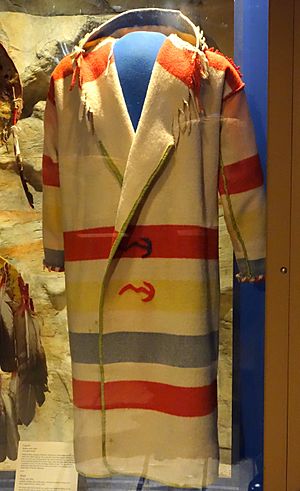
- Canada – Canada has many traditional clothes from different groups.
- First Nations – They wear buckskins, moccasins, and button blankets. The term regalia is preferred over costume.
- Métis – They wear the Ceinture fléchée (a woven sash) and Capote coats.
- Nunavut and Inuit communities – They wear Parkas and mukluks (soft boots).
- Mexico – The Charro outfit and Sombrero are famous. The China Poblana dress is also very well-known. Each state has its own typical folk dress.
- United States – The U.S. has many traditional styles.
- Alaska – Kuspuks and parkas are traditional for native people.
- Hawaii – The Aloha shirt and Muumuu are traditional Hawaiian clothes.
- American Southwest – Western wear is common, including cowboy hats, Western shirts, and jeans.
- Amish communities – They wear plain dress, which is simple clothing.
- Native American clothing – This includes Moccasins and war bonnets. Regalia is the preferred term.
Oceania
Oceania's traditional clothing often features natural materials and vibrant designs.
Australia and New Zealand
- Australia
- Aboriginal Australians – They wear fibercraft-made clothing.
- European Australians – Bushwear includes Moleskin trousers and the Akubra hat.
- New Zealand
- Māori – They wear Piupiu (a skirt) and korowai (a cloak).
Melanesia
- Fiji – The Sulu and Tapa cloth (called masi) are traditional.
- Papua New Guinea – The Meri blaus and lap-lap are common.
Polynesia
- Samoa – People wear the Lavalava and Puletasi.
- Tonga – The Tupenu and Ta'ovala (a mat worn around the waist) are traditional.
South America
South America's folk costumes reflect its mix of indigenous, European, and African influences.
- Argentina – The Gaucho costume is famous, including different types of poncho.
- Bolivia – People wear the Poncho, Chullo (a knitted hat), and Andean pollera (a layered skirt).
- Brazil – Each region has its own traditional costume.
- Chile – The Huaso costume includes the Chamanto (a poncho) and Chupalla (a straw hat).
- Colombia – The Sombrero Vueltiao (a woven hat) and ruana (a type of poncho) are traditional.
- Ecuador – The Poncho and Panama hat are common.
- Peru – People wear the Chullo, Poncho, and Andean pollera.
- Venezuela – The Llanero costume includes the Liqui liqui suit.
Images for kids
-
Palestinian costume from Bethlehem.
-
A 1831 picture of the folk costume of the Kuopio people in Finland
-
Morris dancing in English folk costumes
-
Traditional kroj from Slovakia.
-
Andalusian folk costumes from Spain.
-
Tricana from Portugal.
-
China Poblana dress, emblematic of the City of Puebla and sometimes considered the national costume of Mexico.
-
Blue jeans, Stetsons and press stud plaid Western shirts, c.1950
See also
 In Spanish: Traje típico para niños
In Spanish: Traje típico para niños



